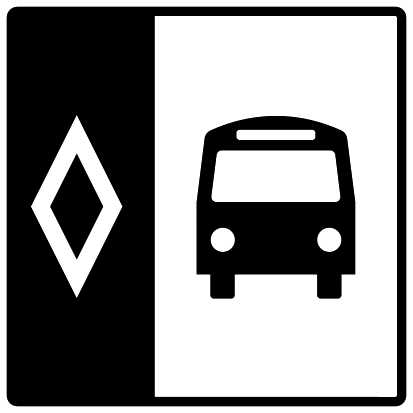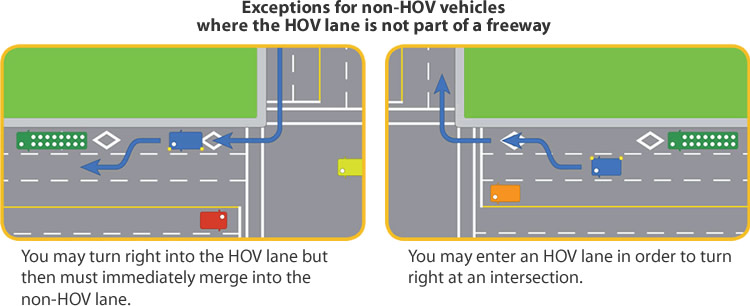HOV lanes
High occupancy vehicle (HOV) lanes are reserved for high occupancy vehicles in B.C.
HOV lanes move more people in fewer vehicles than regular lanes. This uses less energy and reduces greenhouse gas emissions. It also helps people get to their destinations more quickly by reducing congestion from single-occupant vehicles.
HOV lanes are on several provincial highways and urban corridors in the Lower Mainland and Kelowna.
On this page
Who can use HOV lanes?
The Motor Vehicle Act Regulation - Division 42 High Occupancy Vehicles sets out the rules for HOVs and other types of vehicles allowed in HOV lanes.
Vehicles under 5,500 kg gross vehicle weight that have the minimum number of occupants (as posted on signs) can use HOV lanes. Buses can also use HOV lanes.
Vehicles 5,500 kg gross vehicle weight and over (except buses) are not allowed to use HOV lanes, even if they are transporting enough people to qualify.
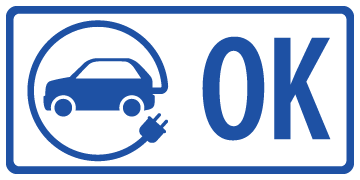
Apply for electric vehicles in HOV lanes
Drivers and manufacturers can apply for electric vehicles to have access to HOV lanes in B.C. regardless of the number of passengers in the car.
Exceptions
Some vehicles can use HOV lanes even if they do not meet the minimum number of occupants.
These include:
- Emergency vehicles
- Motorcycles
- Cycles
- Taxis (ride-hailing vehicles are not exempt from HOV lane requirements)
- HandyDART vehicles
- Electric vehicles (EVs) displaying an official decal
- Blood delivery vehicles when transporting blood or blood products
- Peace officer on active duty
- Marked vehicles responding to a disabled vehicle or other emergency on the highway
Some HOV lanes have different rules and may not allow all these vehicles. Make sure to pay attention to the signs at each HOV lane.
Electric vehicles (EVs) in HOV lanes
Owners of qualifying low-emission vehicles weighing less than 5,500 kg can apply for a decal to drive in HOV lanes on B.C. highways.
HOV signs and markings
Drivers of motorcycles, cycles, taxis, HandyDARTs or electric vehicles displaying an official decal cannot use an HOV lane if a sign prohibits their use.
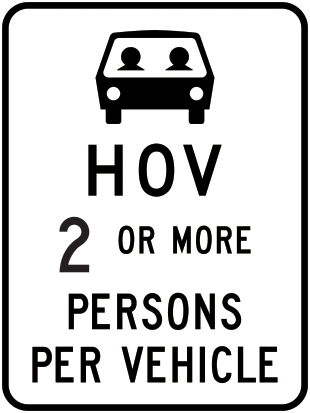
Passenger vehicles and buses can use HOV lanes if they are carrying the number of people shown on the HOV sign.
Why are some HOV lanes on the left and some on the right?
There are two types of HOV lanes:
Freeway (high-speed corridor)
On freeways, the HOV lane is usually the left-most lane. It is designed as a continuous access freeway (allowing vehicles to enter or exit continuously along the freeway) and has longer distances between interchanges.
Urban corridor (lower-speed corridor)
In urban corridors, the HOV lane is in the right-most curb lane. Vehicle entry to and exits from the HOV lanes are distributed along the corridor more frequently.
You must enter and leave HOV lanes only when the line between lanes is a broken line.
Related Links
- Car Sharing Canada
- CleanBC
- CleanBC Go Electric
- Electric Vehicles in Vancouver
- Go Electric Home and Workplace Charger Rebates
- MVA - s. 152 - High Occupancy Vehicle Lane
- MVA - Div. 42 - High Occupancy Vehicles
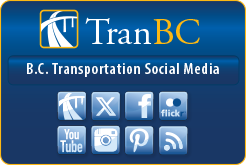
Contact information
HOV General Inquiries:

